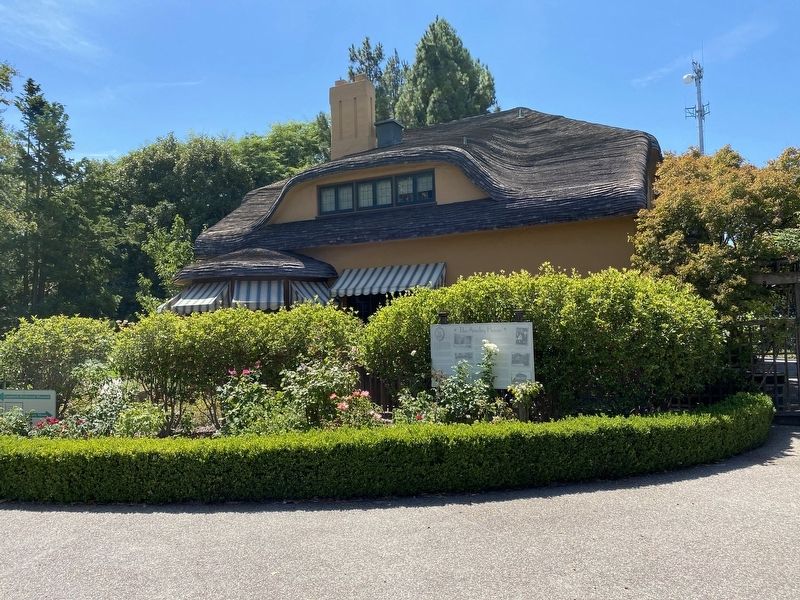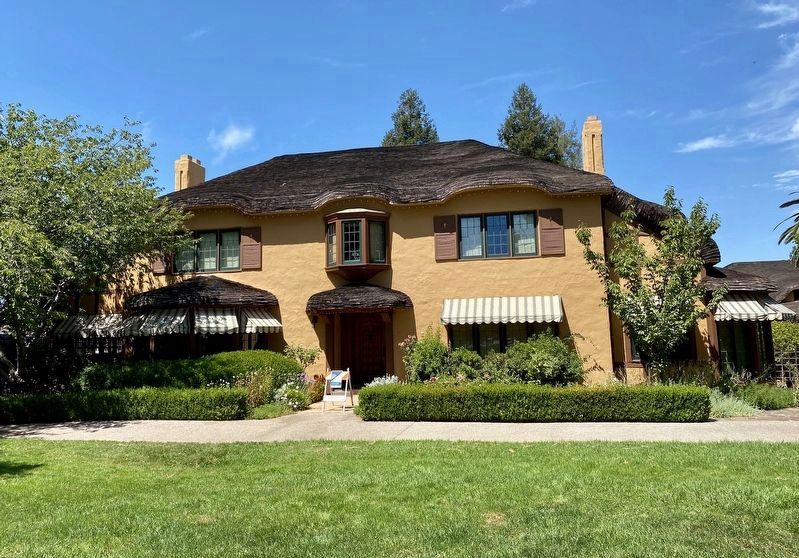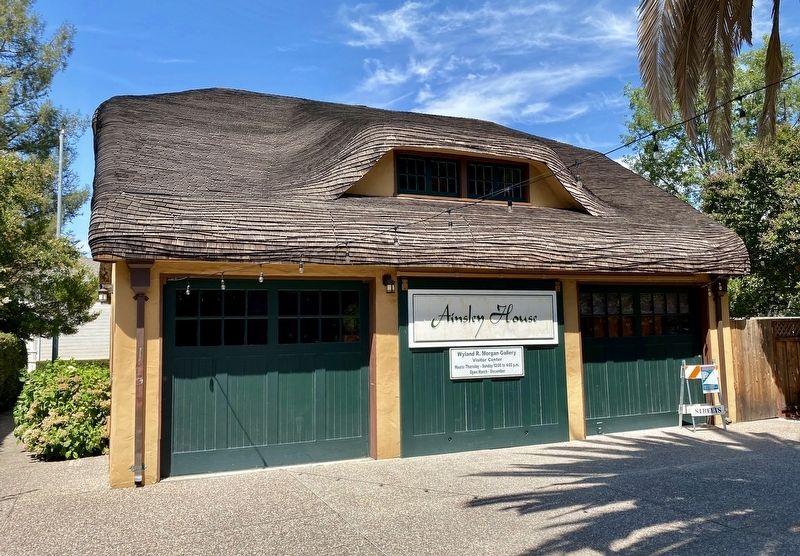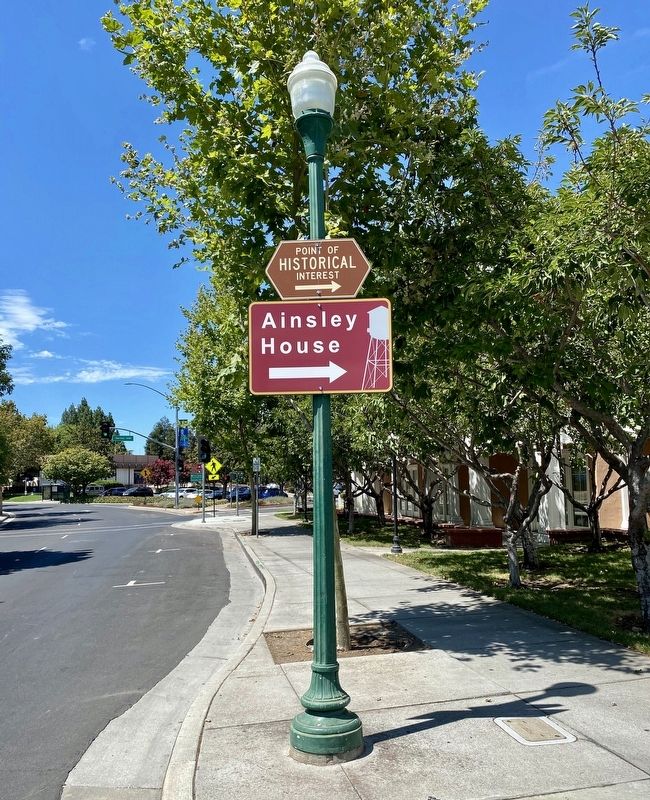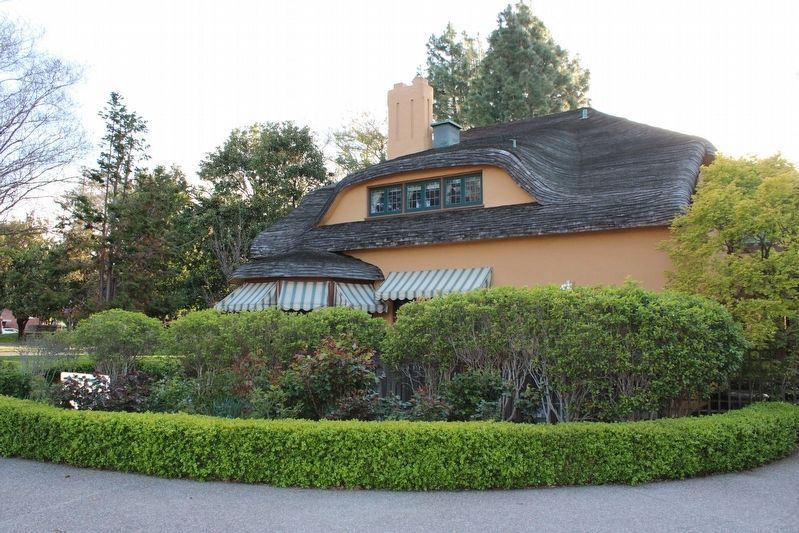Downtown in Campbell in Santa Clara County, California — The American West (Pacific Coastal)
The Ainsley House
The house stands as a symbol of his success and a time capsule of the 1920's. Donated to the City of Campbell by the Ainsley's granddaughters, Geraldine Lloyd Hicks and Georgene Lloyd Bowen, the furniture and furnishings are largely original, having been loaned or donated by the family.
BIOGRAPHY
John Colpitts Ainsley was bom in 1860 in Stokesley of Yorkshire, England. J.C. received very little formal education. He immigrated to Fields, Ohio in 1884 where he farmed for his uncle until he left for California two years later.
He arrived in Campbell in 1886, the same year the Campbell railway station opened. He earned enough money to buy his own farm by working on established orchards and selling fruit trees. With the encouragement of his brother, Thomas, he was determined to export Santa Clara Valley fruit to his home country. He built a primitive cannery on his first ranch. Success came in 1891 when he exported 1,000 cases of tinned fruit to England where it was received with delight. In 1892, he went into partnership with his brother Thomas, became an American citizen, and bought land alongside the railway line.
The J.C. Ainsley Packing Company was a huge success and became the largest employer in Campbell. The cannery boasted a nurse in attendance, hot meals, a daycare center for the children of his employees and 20-25 cottages built east of the railway lines specifically for migrant workers. Production averaged 5,000 to 6,000 tons of fruit each year with most of it shipped to England.
J.C. bought his first home and small ranch in Campbell in 1887 on the northeast corner of Winchester and Campbell Avenues. In 1925, the Ainsleys moved into their third and final new home. The Ainsleys purchased all new contemporary period furniture. The furnishings reflect the best money could buy for the time. However, the Ainsleys only lived here for twelve years; J.C. died in August of 1937, at age 77. After his death Alcinda left the house to live with friends and never returned. She passed away 18 months later, in February of 1939. The house remained unoccupied for forty years, though the family did take up residence for a period each Christmas and used the house for certain social events.
A succession of caretakers lived on the premises in the Carriage House apartment to prevent vandalism. The surrounding orchard was eventually sold for development. In the late 1970's some restoration work took place and parts of the house were used for offices. The house was given to the City of Campbell in 1989, but at that time, the property was no longer within Campbell city limits. The house was moved to its present location in 1990.
ARCHITECTURAL FEATURES
The house was built on the southwest corner of J.C. Ainsley's 83-acre orchard at present day Hamilton and Bascom Avenues. Constructed in 1925, the house is a Tudor Revival. The original roof, made to resemble an English thatch roof, was made of cedar shingles shaped by steaming. The roof survived over 80 years before replacement was necessary in 2007. The stucco exterior of the Ainsley house is broken by half-timbering, with the chimneys showing fluting and chimney pots. The roof, with its thatched effect, is broken by copper gutters visible above the eyebrow windows at the east and west ends. The woodwork on the house is painted. Originally the outside woodwork was all stained and varnished like the front porch area.
The arch door with a lion head knocker and carvings of oak leaves and acorns were typical Tudor features. This design honors the medieval superstition that the good spirits lived in the oak trees and had to be appeased; hence the saying, "Knock on wood.” The Carriage House, now known as the Morgan Gallery, originally comprised a three-car garage, a tool room, a laundry, and an apartment on the second floor for the gardener.
The only major external architectural difference between the main house and Carriage House is that the downspouts are hidden in the fabric of the main house but are external on the Carriage House. Built on two floors, the house comprises 5,000 square feet. The attic and a basement add approximately another 1,000 square feet. It was the largest home owned by the Ainsleys and cost about $50,000 to build. On November 18, 1990, the Ainsley House was moved at a cost of $230,000 to its present location on Grant Street.
The house, now fully restored and carefully maintained was put on the National Register of Historic Places in 2005. It is a tangible reminder of the past when the Santa Clara Valley, famous for its fruit, was known as the Valley of the Hearts Delight, and Campbell was The Orchard City.
Topics. This historical marker is listed in these topic lists: Agriculture • Industry & Commerce. A significant historical month for this entry is February 1939.
Location. Marker has been permanently removed. It was located near 37° 17.324′ N, 121° 56.608′ W. Marker was in Campbell, California, in Santa Clara County. It was in Downtown. Marker could be reached from Grant Street. Touch for map. Marker was at or near this postal address: 300 Grant Street, Campbell CA 95008, United States of America.
We have been informed that this sign or monument is no longer there and will not be replaced. This page is an archival view of what was.
Other nearby markers. At least 8 other markers are within walking distance of this location. A different marker also named The Ainsley House (a few steps from this marker); a different marker also named Ainsley House (a few steps from this marker); Campbell Fire Station (about 400 feet away, measured in a direct line); Fire House #1 (about 400 feet away); Gilman House (about 500 feet away); Farley Building (about 600 feet away); Lena Swope French House (about 600 feet away); Bank of Campbell (Farley Building) (about 600 feet away). Touch for a list and map of all markers in Campbell.
More about this marker. The marker has been removed. A new, similar marker has been placed on the carriage house.
Also see . . . The Ainsley House (Campbell Museums). "The Ainsley House is Campbell's historic house museum.
The home was built in the style of an English Tudor Cotswold cottage during the Arts and Crafts movement. Built in 1925, the home was the third residence of local canning pioneer, John Colpitts Ainsley and his wife Alcinda Ainsley." (Submitted on September 15, 2020, by Andrew Ruppenstein of Lamorinda, California.)
Credits. This page was last revised on April 23, 2023. It was originally submitted on September 15, 2020, by Andrew Ruppenstein of Lamorinda, California. This page has been viewed 283 times since then and 26 times this year. Photos: 1, 2, 3, 4, 5. submitted on September 15, 2020, by Andrew Ruppenstein of Lamorinda, California. 6. submitted on April 23, 2023, by Joseph Alvarado of Livermore, California.

